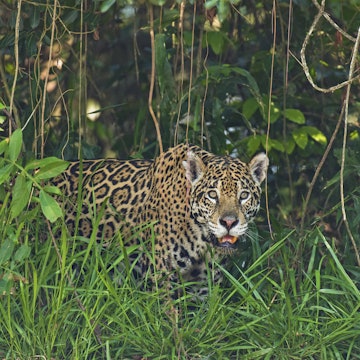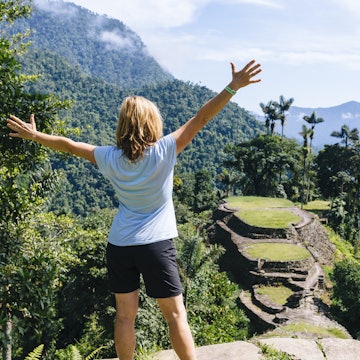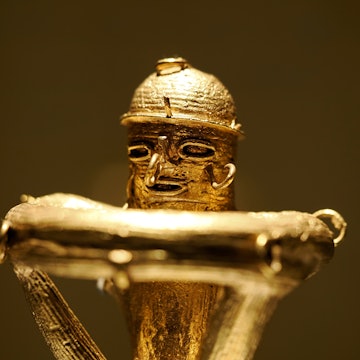
Where the river runs red: a family adventure to the heart of former FARC territory

Mar 25, 2020 • 8 min read
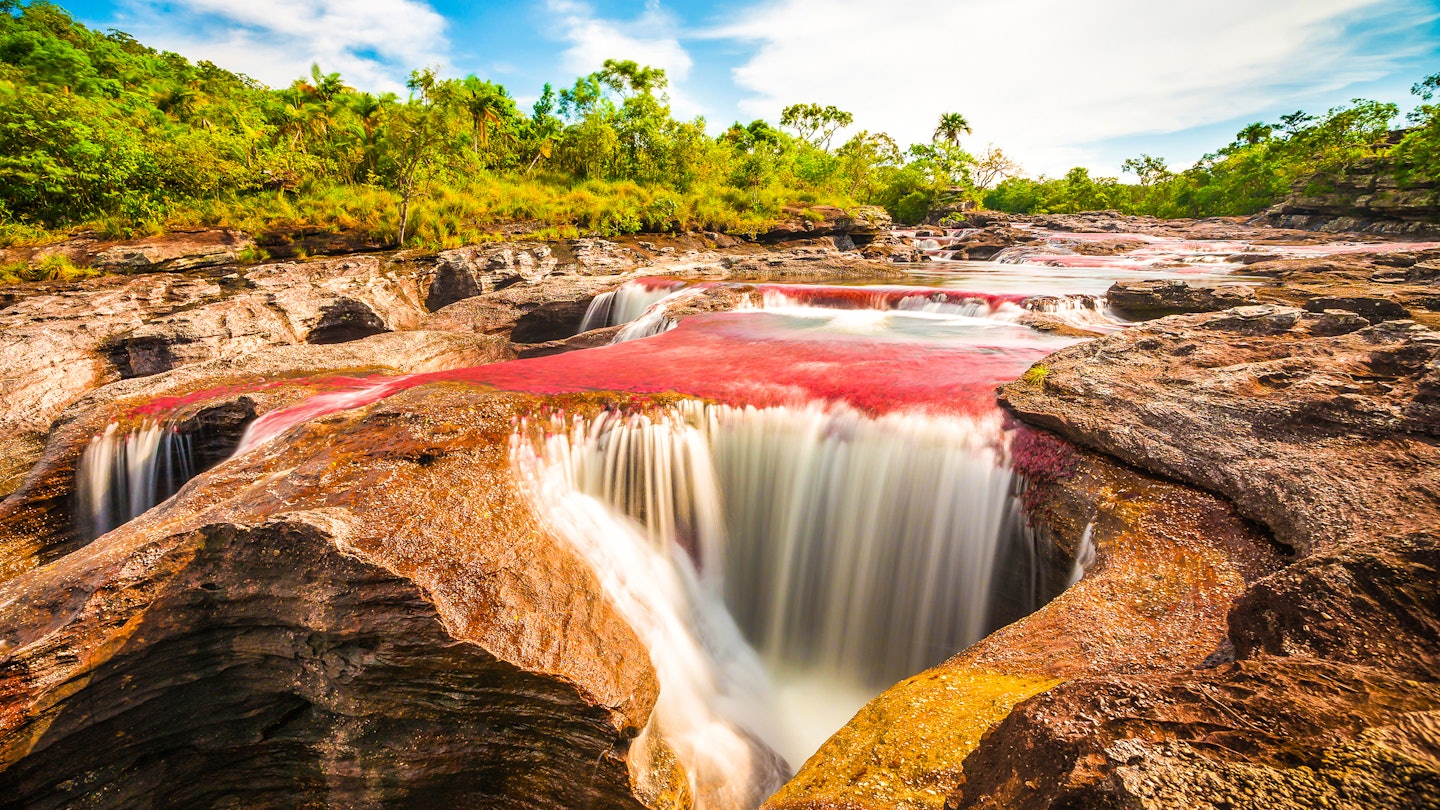
Multicolored river in Colombia, Cano Cristales. VarnaK / Shutterstock
Photographer and writer Laura Watilo Blake and her husband adopted their daughter from Colombia, and they routinely return to explore this vibrant country that has become an important part of their family's story. On a recent trip, they sought out a natural wonder that wasn't accessible to most tourists just a few years ago.

It’s a place of legends and liquid rainbows, but until 10 years ago, the brilliantly hued river known as Caño Cristales was located deep in FARC territory. Now, my husband and I are bringing our five-year-old to the nearest town, La Macarena, Colombia, to see the remote crystal-clear river, which runs red from late June to November when a rare aquatic plant known as Macarenia Clavigera blooms just beneath the surface.
The adventure to get to this backwater rivals the settings of the story books my daughter has on her shelf at home. However, boating miles upriver with rain pelting our faces, bouncing over a rutted makeshift road that was carved out of the jungle to transport cocaine, and slogging along muddy trails that could swallow us whole don’t come close to rivaling the true impediments to our family’s happy ending.
Getting there is half the battle
Our journey is nearly sidelined before leaving the United States due to a shortage of the yellow fever vaccine, which is required for all passengers boarding a flight to La Macarena. If we were to arrive in Colombia at least 10 days before flying to La Macarena, we would be able to get a free yellow fever vaccine at El Dorado International Airport in Bogotá, which has its own travel clinic. But that’s not possible for us. Making matters worse, my husband, Chris, and I previously got the vaccine years ago, but threw away the canary-colored Certificate of Yellow Fever Vaccination after its 10-year expiration date.
Since 2016, though, the vaccine has been deemed valid for life, so had we kept the certificate, we would only need to get a replacement with a new expiration date. Meanwhile, our daughter, Kinley – a Colombian native – already has her vaccine, but we only had a copy of the certificate. We eventually track down the original with the help of a friend in Bogotá, who is joining us on the trip to Caño Cristales with three of her family members.
After sorting through our vaccinations, I start by booking rooms six months in advance at the Hotel San Nicolás in La Macarena, working closely with Adriana from the onsite A.S. Hotels & Tours to make sure the trip would be suitable for my daughter. While she strongly discourages families with children under the age of five from attempting the adventure, she assures me there are shorter routes in the park that are suitable for younger travelers. She helps us secure tours, guides and the proper permits for entrance into the Parque Nacional Natural Sierra de la Macarena.
The Colombian authorities place limits on the daily number of visitors to each sector of the park in order to protect the delicate ecosystem. The maximum number of visitors is capped at 452, but only 172 can be in the Caño Cristales sector on a given day, and the majority of the slots are given to the local tour agencies. Official recommended tour agencies are listed on page 24 of the national park’s official guide to Caño Cristales. It’s also possible to request permits directly via email to Parques Nacionals and Regional Macarena, but you’d have to secure your own guide in La Macarena as it’s off limits to enter the park on your own.
With our permits and tours confirmed and the deposit paid, we buy our tickets on Satena Airlines, the only airline that flies into La Macarena. Flights are offered from Bogotá on Wednesday, Friday and Sunday, plus occasional Mondays when they fall on a holiday. We saved hundreds of dollars by booking the hotel, airfare and tours separately, but for those who wish to avoid the hassle, there are plenty of three-day, two-night packages that include airfare, hotel, tours, guides, permits and taxes, plus meals.
Touching down in La Macarena
Our itinerary is so tightly scheduled that visitors are encouraged to dress in the first day’s hiking attire on the flight to La Macarena, a remote one-horse town tucked away in the department of Meta. We are dressed in long sleeves and long pants when we step off the plane and into a tropical blast furnace.
Neither sunscreen or insect repellent can be worn while in the park because their effect can be detrimental to the health of the plants we've come to see. This rule is stressed moments later when we make a compulsory visit to the nearby office of Cormacarena, the entity that enforces sustainable-tourism practices in the park, instructs visitors about the impact humans have had on the ecosystem and distributes wristbands for entry.
The excitement truly starts to build later when our group of seven, plus our guide, Rigo Cifuentes Acebedo, and a boat driver load into a motorized canoe to head upriver for the first of three forays into the park via the Guayabera River. Each day, Rigo points out creatures at the water’s edge, especially a diverse number of birds and monkeys, plus an occasional sloth curled around a branch stretched over the river.
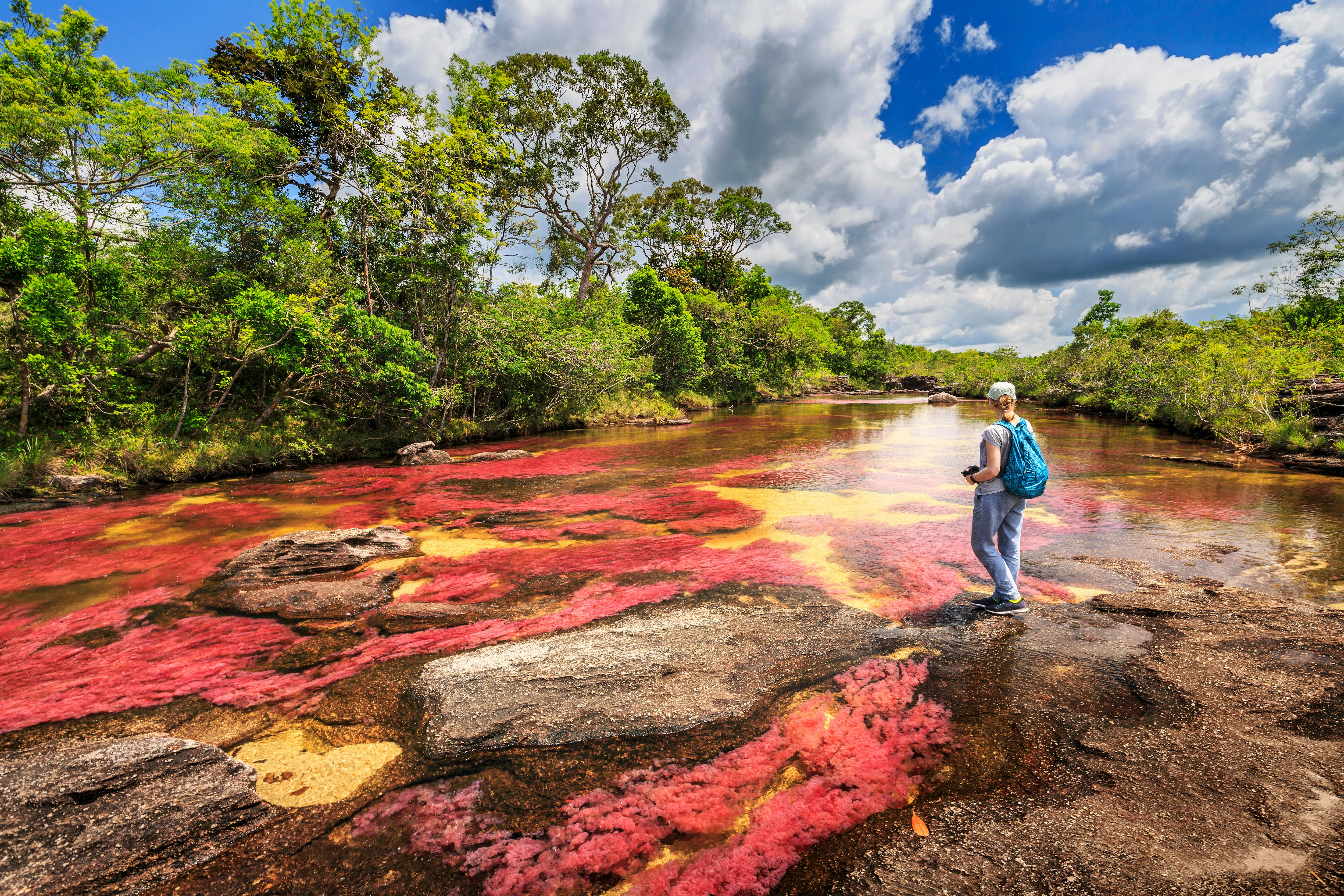
The trip lengths vary depending on where in the park we are authorized to visit each day. When bad weather threatens, Rigo adjusts the itinerary and secure permits for alternative excursions. We still manage to get drenched by intermittent tropical rain showers, but the discomfort is forgotten with the appearance of vibrant rainbows on the horizon.
The liquid rainbow known as Caño Cristales originates high in the Serrania de la Macarena, a mountain range uniquely located at the point where the Andes, the Amazon Rainforest and the savannahs of the Eastern Plains meet. This is most obvious on our first day when visiting Cristalitos, a smaller tributary of Caño Cristales. The canoe pulls up below a magnificent waterfall and we begin our hike up the side of a mountain along a forested path. Kinley effortlessly scrambles over rocks, occasionally with help from us or the guide.
Once at the summit, we have a panoramic view of the river stretching for miles in either direction. It’s a great spot to appreciate the geography of the region. The landscape then flattens out and we trudge across a shadeless páramo, characterized by low shrubs, grasses and even a few palm trees. An hour later, we finally get the first glimpse of a shallow stream carpeted by the scarlet-colored macarenia clavigera that’s unique to this region. Often mistaken for a type of algae, the plant is actually a weed from the botanical plant family Podostemaceae.
Bending down over the water for a closer look, the unusual plant clings to the underlying rocks and pulsates in the current like alveoli filtering oxygen from the bloodstream in human lungs. While it blooms bright red in the sun, it stays a whitish-green color in the shady spots where the light doesn’t reach. Those hues, combined with the yellowish sand, black rocks, surrounding greenery and blue sky is the reason Caño Cristales is known as the “river of 5 colors,” the “liquid rainbow” and even “the river that escaped from paradise.”
Careful not to disturb the rare flora, we follow the stream to a deeper pocket of water where we can jump in to cool off, a process that would repeat itself every day. It’s in the water where Kinley is at her happiest, although she is a good sport the entire time we were exploring the park. She is bolstered by passing comments from other tourists and guides. “!Ella es muy valiente!” they all say— "she’s very brave.”
Kinley’s brave face is on the next day during a trek to a set of rock formations known as Ciudad de Piedra (City of Rock), when her feet get sucked into the mud and she face plants into the sticky goo under a canopy of giant tropical plants that make us feel like tiny leaf-cutter ants. She gets right back up again, strips off her once-white leggings now stained a deep brown, and skips down the trail in just her bathing suit with more energy than the rest of us.
On the morning of our return flight to Bogotá, we made one last short excursion into the park at a section of Caño Cristales that includes some of the areas most-iconic spots, including El Tapete, Piscina del Turista, Piscina de Carol Cristal and Los Ochos.
Getting there requires a short boat ride, then a 25-minute spine-cracking drive by 4x4 over a bumpy road hastily carved out of the landscape by the Revolutionary Armed Forces of Colombia (FARC) to quickly transport drugs, guns and provisions. In the early 2000s, the military launched an effort to take back control of the region and now that same road transports the many eco-tourists that come to marvel at Colombia’s alluring natural wonder.
Soldiers still patrol the water’s edge, reminding us that dangers lurk in the remote countryside, but the threat of paramilitary activity is small compared to the dangers of climate change and too many people spoiling this unique blood-red river that we feel privileged to be able to visit. Reaching Caño Cristales has been one of the most bold adventures we’ve had as a family – a great story we’ll be able to tell for the rest of our lives. We close the book on this chapter as the 22-seat prop plane lifts into the sky to carry us back to Bogotá and onward to the many more escapades to come.
The novel coronavirus (COVID-19) is now a global pandemic. Find out what this means for travelers.








